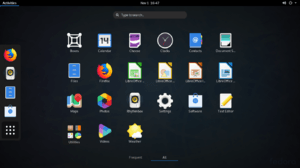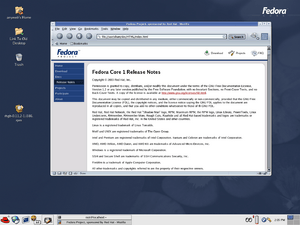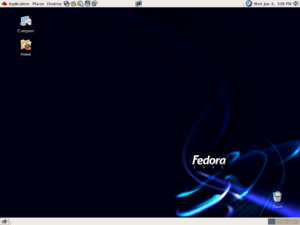Fedora (operating system) facts for kids

Fedora 31 running GNOME
|
|
| Company / developer | Fedora Project |
|---|---|
| OS family | Linux |
| Working state | Current |
| Source model | Open source |
| Latest stable release | 31 / 29 October 2019 |
| Update method | Yum, Anaconda |
| Package manager | RPM Package Manager |
| Supported platforms | x86, X86-64, ARM |
| Kernel type | Monolithic kernel |
| Default user interface | GNOME |
| License | Free software licenses (mainly GPL) |
| Official website | fedoraproject.org |
Fedora is a type of Linux operating system. It's like Windows or macOS, but it's free and open source. This means anyone can use it, change it, and share it. The Fedora Project community develops Fedora, and a company called Red Hat helps support it.
Fedora is made to be very safe and is used by many companies and governments. Its main goal is to quickly improve free and open source software.
Did you know that Linus Torvalds, the person who created the Linux kernel (the main part of the Linux operating system), uses Fedora? He started using it because it worked well with a certain type of computer chip he had. He liked it so much that he kept using it!
Contents
Fedora Versions Over Time
Fedora has had many different versions, each with new features and improvements.
Early Fedora Versions (Core 1-4)
- Fedora Core 1 was the very first version. It came out on November 6, 2003, and was called "Yarrow." It used an older version of Linux and the GNOME and KDE desktop environments.
- Fedora Core 2 was released on May 18, 2004, named "Tettnang." This version included a newer Linux kernel and SELinux, which helps make the system more secure. It also switched to X.org for displaying graphics.
- Fedora Core 3 came out on November 8, 2004, called "Heidelberg." This was the first Fedora to include the Mozilla Firefox web browser. It also added support for many different languages, especially those from India. This version also made SELinux active by default, but in a way that was less strict.
- Fedora Core 4 was released on June 13, 2005, and was named "Stentz." It introduced a new look called "Clearlooks." This version also included the OpenOffice.org office programs and Xen, which helps run multiple computer systems on one machine. It also added support for PowerPC computer chips.
More Fedora Core Versions (Core 5-6)
These versions started a trend of having special artwork for each release.
- Fedora Core 5 was released on March 20, 2006, called "Bordeaux." It brought in the "Fedora Bubbles" artwork. This version also included new tools for managing software packages.
- Fedora Core 6 came out on October 24, 2006, named "Zod." This name came from a famous villain in Superman comics! It introduced the "Fedora DNA" artwork. This version also added support for cool visual effects on your desktop, like Compiz.
It's important to know that the Fedora Project no longer supports these older "Core" versions.
Fedora 10
Fedora 10, known as Cambridge, was released on November 25, 2008.
History of Fedora Versions
This table shows the different versions of Fedora over the years.
| Color | Meaning |
|---|---|
| Red | This version is no longer supported. |
| Green | This version is still supported. |
| Blue | This is a future version. |
| Project Name | Version | Code name | Release date | Kernel version |
|---|---|---|---|---|
| Fedora Core | 1 | Yarrow | 2003–11–05 | 2.4.19 |
| 2 | Tettnang | 2004–05–18 | 2.6.5 | |
| 3 | Heidelberg | 2004–11–08 | 2.6.9 | |
| 4 | Stentz | 2005–06–13 | 2.6.11 | |
| 5 | Bordeaux | 2006–03–20 | 2.6.15 | |
| 6 | Zod | 2006–10–24 | 2.6.18 | |
| Fedora | 7 | Moonshine | 2007–05–31 | 2.6.21 |
| 8 | Werewolf | 2007–11–08 | 2.6.23 | |
| 9 | Sulphur | 2008–05–13 | 2.6.25 | |
| 10 | Cambridge | 2008–11–25 | 2.6.27 | |
| 11 | Leonidas | 2009–06–09 | 2.6.29 | |
| 12 | Constantine | 2009–11–17 | 2.6.31 | |
| 13 | Goddard | 2010–05–11 | 2.6.33 | |
| 14 | Laughlin | 2010-11-02 | 2.6.35 | |
| 15 | Lovelock | 2011-05-24 | 2.6.38 | |
| 16 | Verne | 2011-11-08 | 3.1.0 | |
| 17 | Beefy Miracle | 2012-05-29 | 3.3.7 | |
| 18 | Spherical Cow | Late 2012 | 3.6 | |
| 19 | Schrödinger's Cat | 2013-07-02 | 3.9 | |
| 20 | Heisenbug | 2013-12-17 | 3.11 | |
| 21 | 2014-12-09 | 3.17 | ||
| 22 | 2015-05-26 | 4.0 | ||
| 23 | 2015-11-03 | 4.2 | ||
| 24 | 2016-06-21 | 4.5 | ||
| 25 | 2016-11-22 | 4.8 | ||
| 26 | 2017-07-11 | 4.11 | ||
| 27 | 2017-11-14 | 4.13 | ||
| 28 | 2018-05-01 | 4.16 | ||
| 29 | 2018-10-30 | 4.18 | ||
| 30 | 2019-04-30 | 5.0 | ||
| 31 | 2019-10-22 | 5.3 | ||
| 32 | 2020-04-21 |
Fedora Gallery
Software Packages
Fedora has an official place where you can find and install many software programs. One example of a program you can find there is UNetbootin.
Related pages
- List of Linux distributions
- Fedora at DistroWatch
Images for kids
See also
 In Spanish: Fedora (sistema operativo) para niños
In Spanish: Fedora (sistema operativo) para niños





















